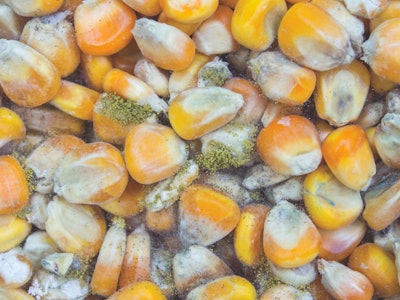
‘Everybody needs to test,’ technician says after tests detect high concentrations of mycotoxins in animal feed
After 2019’s harvest, high levels of mycotoxins have begun to crop up in animal feed and forage across North America, with likely ties to last year’s delayed harvest and wet weather.
Despite initial data suggesting this year’s crop may have evaded predictions of widespread contamination, pockets of high levels of contamination have begun to appear in samples analyzed by Alltech, according to a technician with the company’s mycotoxin management team.
Though mycotoxins aren’t necessarily more prevalent in this year’s analysis — Alltech’s Max Hawkins said the average sample of silage from this past harvest was within normal limits — some samples have contained toxins “way above average.”
Some samples have contained deoxynivalenol (DON) in concentrations two to three times beyond the level thought to pose a high risk to ruminants, Hawkins said. Zearalenone (ZEN) and T-2 have also significantly exceeded risk screening levels in many samples, he said. In addition to mycotoxins, he said, this year’s silage tends to lack proper fermentation, may run dry and have low nutrient content.
“I’m having a hard time getting my head wrapped around that a little bit, except I know the last two years have been wetter,” Hawkins said. “Moisture, precipitation is one of the biggest factors in generating molds and subsequent mycotoxins.”
The tests aren’t entirely surprising given the extreme weather that plagued Canada and the U.S. during the past harvest season, but initial tests intended to screen mycotoxins didn’t necessarily pick up on the level of contamination, Hawkins said. He believes this is because the bulk of the contamination is tied to the late harvest, which was delayed in many regions due to wet, cold weather.
“If you look at a lot of those samples, the early samples that were done, kind of when most things normally would have been harvested, the risk looked relatively low,” he said. “But then as we got into the delayed harvest, that’s when our risk really started to pick up.”
Grains and silage harvested in a timely fashion likely poses low risk, Hawkins said. But in some areas, where the harvest dragged on for 2-3 months, feed could contain significantly higher levels of mycotoxins than normal. Depending on the local microclimate, the risk could vary significantly from one farm to the next and may not be immediately apparent.
“Everybody needs to test” for mycotoxins, Hawkins said. “If you grow your own, you need to test. If you purchase, you need to test.”
Storage will also prove critical this year, Hawkins said.
“As we begin to warm up into ambient temperatures around 45-50 degrees, we can start to get some not-so-good things happening in stored ingredients,” he said. “Water activity could pick up, molds will start to flourish, and as we get more mold we not only take away nutrition, but have a greater risk of mycotoxins in storage.”

















